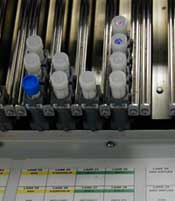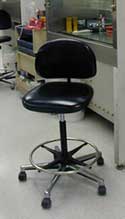Hospitals eTool
Laboratory » Work-related Musculoskeletal Disorders
Hazard
Laboratory employees are exposed to ergonomics-related risk factors such as static postures while sitting or standing for prolonged time, repetitive movements if sorting samples or using the computer, forceful exertions, awkward postures and contact stress. Exposure to ergonomics hazards may lead to Work-Related Musculoskeletal Disorders (MSDs) including carpel tunnel syndrome, tendonitis, tenosynovitis, and back pain.


Recognized Controls and Work Practices
- Install automated tract delivery systems for specimen processing to minimize employee reaching and repetitive motions.
- Provide supportive comfortable chairs that include foot rests, and ensure that there is knee clearance under the lab table.
- Provide adjustable work stations that have sufficient room for the legs. Ensure that the knees do not hit the laboratory bench.
- Rotate tasks or minimize the amount of time spent at these tasks.
- Provide ergonomic computer workstations for sitting and standing workstations.
- Provide anti-fatigue mats for standing workstations.
- Provide ergonomic microscopes and pipettes. Separate supports may be needed for the arms when working with microscopes.
- Provide handling devices to move and lift full carboys (containers).
Additional Information
- Laboratory. OSHA Safety and Health Topics Page.
- Laboratory Safety Guidance. OSHA Publication 3404, (2011).
- Hazard Identification Training Tool. OSHA.
- Ergonomics. OSHA Safety and Health Topics Page.
- Inspection Guidance for Inpatient Healthcare Settings. (June 25, 2015). OSHA memorandum establishing guidance for inspections conducted in inpatient healthcare settings.
- Also see Hospital-wide Hazards - Work-related Musculoskeletal Disorders.

